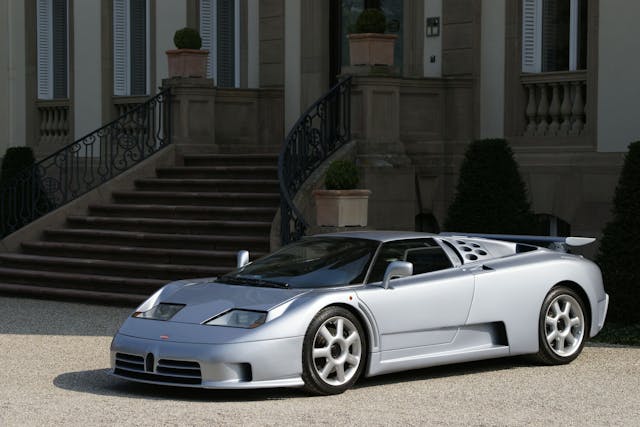EB110 at 30: The bonkers ’90s supercar that revived Bugatti
On the afternoon of Sunday September 15, 1991, thousands of people lined the Champs-Élysée in Paris to witness the rebirth of Bugatti. Exactly 110 years since Ettore Bugatti was himself born, movie star Alain Delon piloted the astonishing new EB110 through the streets of the French capital, while across the border in Italy a brand-new factory was ready to start delivering the fastest production super sports car the world had ever seen.
Dormant since the 1950s, Bugatti was back with a vengeance. Magazine road testers were wowed, Formula 1 stars joined the line to buy and the company even ventured back to the hallowed ground of Le Mans.
The Bugatti blueprint was nothing if not ambitious. Unfortunately, global economics did not favor the enterprise and Bugatti would shutter its doors for a second time in 1995.
After being saved by the Volkswagen group in 1997, launching first the Veyron and then Chiron, Bugatti now falls under the stewardship of Rimac and electrification is set to follow. Yet none of this would have happened where it not for the passion of Romano Artioli and his vision for the storied French marque. As we mark 30 years since its debut let’s take a look back at the bonkers Bugatti EB110.

Revived by an Italian Suzuki dealer
In 1952, twenty-year-old engineering student Romano Artioli heard the news that Bugatti was to cease production. “If no one reacts to the situation at Bugatti, I will work as long as it takes to one day bring the brand back,” he vowed. It would take quite some time, but Artioli would achieve his dream.
By the 1980s Artioli was Italy’s biggest Ferrari dealer and the first importer of Suzuki cars with the funds to bring Bugatti back to life. After its closure decades earlier the Bugatti brand was officially owned by the French government but Artioli’s negotiating skills paid off and he founded Bugatti Automobili S.p.A. in 1987.
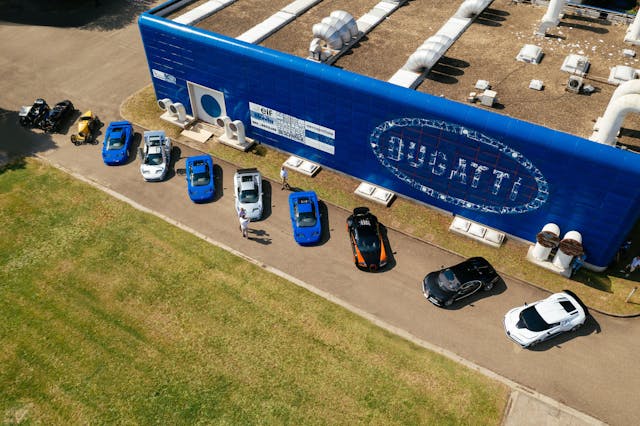
The factory was in Italy, not France
Bugatti’s historical (and current) home was in Molsheim, France, but Artioli believed that the Emilia Romagna region—Italy’s supercar valley–would be the best location for his new car factory.
The Campogalliano facility near Modena could count Ferrari, Maserati, De Tomaso and Lamborghini as neighbors and Artioli reasoned that attracting talent to the fledgling manufacturer would therefore be relatively easy.
The 2.6 million square foot Fabbrica Blu (Blue Factory) was state-of-the-art, with a design studio, engine test facility, production halls, a test track and showroom—even a restaurant. Marble and mosaic floors featured while the huge windows of the main circular building had automatic blinds that reacted to the position of the sun to ensure optimum lighting inside.
As a tribute to the company’s original founder Artioli bought an old wooden door from Molsheim to incorporate into the building, and after three years under construction the plant officially opened on September 15, 1990.
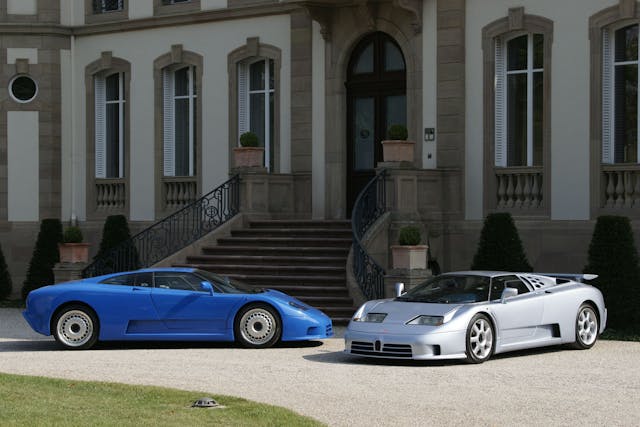
It was designed by Lamborghini alumni
Artioli’s instinct was quite correct and Bugatti was able to call on the very best designers and engineers. Styling proposals were requested from Paolo Martin, Giorgetto Giugiaro, Nuccio Bertone, and Marcello Gandini, while early engineering work was done by Tiziano Benedetti, Achille Bevini and Oliviero Pedrazzi at Tecnostile who had previously worked on the Lamborghini Miura. Paolo Stanzani who had worked on the Miura, Espada, and Countach was subsequently hired as Technical Director. The final design was based on Gandini’s submission, but modified by Gianpaolo Benedini who had designed Fabbrica Blu.
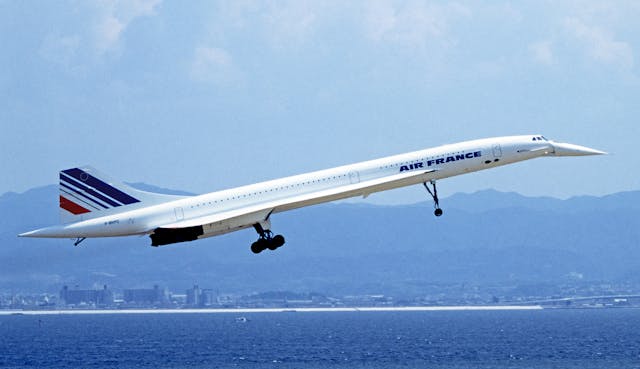
The monocoque was made by aerospace specialists
There was only one material that would suffice when it came to meeting the torsional stiffness specification for the EB110’s monocoque—carbon fiber. The trouble with the carbon fiber technology available in the early 1990s was that nobody in the automotive industry had any experience with it. That led Bugatti to French aerospace firm Aerospatiale, probably best known for its work on the supersonic jet liner Concorde. The tub was duly engineered and supplied by Aerospatiale and weighed in at just 276 pounds. To keep the overall mass to a minimum the bodywork was a mix of carbon, aramid fiber and plastic, while magnesium alloy wheels were fitted and every screw and bolt was titanium.
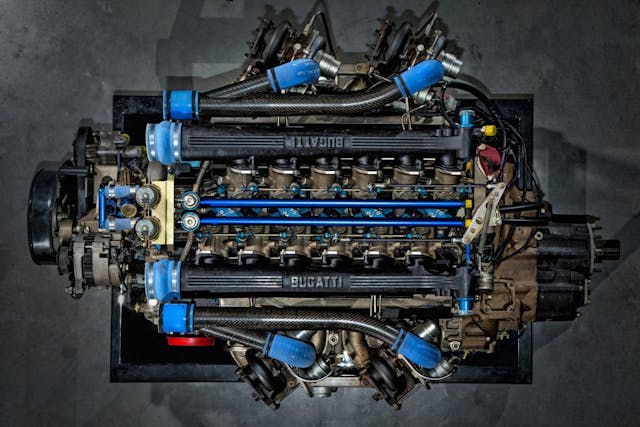
The powertrain was insane
The body and chassis of the EB110 may have been featherweights but the powertrain was a heavy hitter. The 3.5-liter V-12 engine had five valves per cylinder and four turbochargers. Revving to a heady 8250 rpm it produced 560 hp as standard or 610 hp in the later Super Sport. Offering variable boost between 1.05 and 1.2 bar, the turbos were supposed to eliminate lag but the reality was that when you put your toe to the carpet there was a substantial delay before an outrageous explosion of acceleration. Attempting to harness all those horses was a permanent four-wheel drive system with a viscous coupling and a rear limited-slip differential. The torque split was set 27:73 front:rear after the originally-planned 40:60 setup proved too understeery and a conventional six-speed manual transmission took care of gear shifting.
It was a record breaker
Given the EB110’s prodigious power output it was no surprise that it captured a series of world records. The traction of four-wheel drive could catapult the car from 0-62 mph in just 3.26 seconds, making it the fastest accelerating production car of its day. Top speed was 218 mph and the EB110 took home titles for the fastest acceleration, the fastest series production sports car, the fastest sports car running on gas, and, oddly, the fastest series production car on ice.
Michael Schumacher ordered his in yellow
In 1991 Michael Schumacher was 22 years old and in his first season racing for Benetton. Three years later he would be world champion; to celebrate he ordered a Bugatti EB110 Super Sport in bright yellow. The car was unique not just for its bold color scheme, but for the fact that it had a fully luxed-up interior as found in the GT rather than the paired back racier trim of a Super Sport. Schumacher was apparently won over after road testing the car against a Jaguar XJ220, Porsche 911 Turbo, Lamborghini Diablo VT, and a Ferrari F40 for a German magazine. “Michael came to Campogalliano immediately after and purchased a yellow Super Sport with a blue GT interior. He did not ask for a discount—he was clearly a fan,” said Artioli.

Only 128 were made—including 2 race cars
Bugatti EB110 production was cut short after just 128 cars were made in four years. Since then Bugatti has built 450 Veyrons and the Chiron will be capped at 500 units, making the EB110 incredibly rare by comparison. Unlike the current Bugatti management, Artioli’s ambitions extended to the race track and two competition cars were built. One was to target Le Mans and the other IMSA. Qualifying in 17th place the Le Mans car showed a reasonable pace in the 2004 24-hour race, but retired just 45 minutes from the checkered flag. Its U.S. stablemate fared better finishing fifth in class at Watkins Glen in 1995 and sixth overall at Daytona a year later.
It was the most expensive car in the world
The EB110 GT was priced at 450 million Italian lira, or about $500,000 at the time. That made it some 25 percent more than the Ferrari F40, and the most expensive car in the world until the McLaren F1 came along to steal its thunder. On the plus side, Bugatti did throw in a forward-thinking maintenance and parts deal for the first three years. If you’d like one today expect to pay over a million bucks. There’s one for sale now at Copley Motorcars in Needham, Massachusetts.

It should have spawned a super sedan
The next model from Bugatti was to be a front-engined luxury sedan with sensational speed. The Giugiaro-designed EB112 did appear at the 1993 Geneva Motor Show with sleek fastback styling, all-wheel drive, and a claimed top speed of 186 mph. It was “An incredible car, a delight to drive, with a 6.0-liter V-12 installed behind the front axle,” recalls Artioli. “The chassis was made of carbon fiber and the internal suspension was lightweight. It drove like a go-kart.” Sadly it was not to be. Maybe new owners Rimac will revive the idea—electrified for the 21st century and positioned as a kind of Koenigsegg Gemera alternative.
